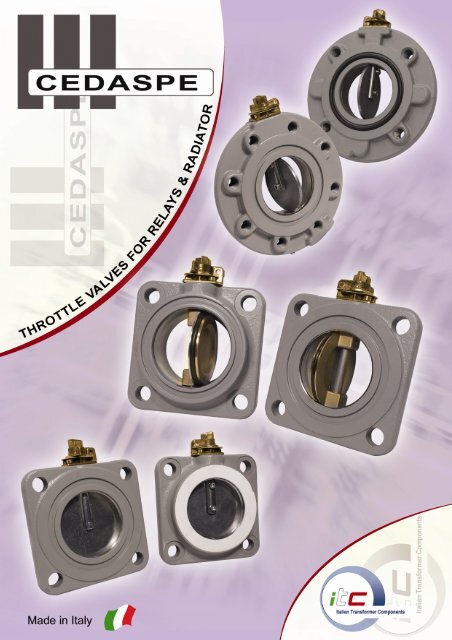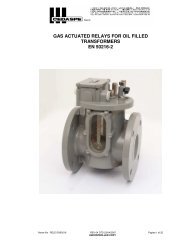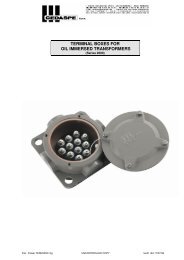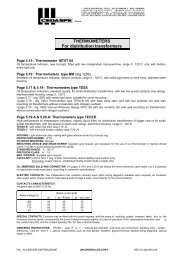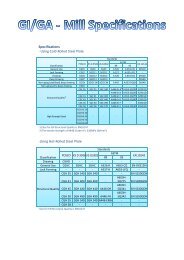You also want an ePaper? Increase the reach of your titles
YUMPU automatically turns print PDFs into web optimized ePapers that Google loves.
THROTTLE VALVES FOR RELAYS AND RADIATORSSeries 20091General Features1.1CharacteristicsThe butterfly <strong>valves</strong>, metal to metal sealing withy thin blade(or full tightening type, with o-ring blade), areused on power transformer with the scope to allow disconnection of a component of the circuit (iebuchholz relay or radiator) without having to lower the oil below the level of the component itself.This kind of valve are preferred to the conventional gate <strong>valves</strong> for their compact overall dimension in thedirection of the oil flow.1.2Field of UseThe butterfly <strong>valves</strong> (standard execution) may be used with the following characteristic values:• Fluid: mineral oil• operating pressure max 10 bar• working temperature from 20°C to + 110°C2Construction Features, Finish and Accessories2.1Construction FeaturesButterfly <strong>valves</strong> are constructed as follows (please refer to drawings):• Body made in forged mild steel• Spindle made in steel• Drive and gland made in brass• Open/close position indicated by a n aluminium plate.• S/steel screws• Throttle made in carbon steel (thin blade) or made in brass (o-ring blade)• O/Rings made in oil resistant rubber2.2FinishBody of wafer type is zinc plated first and after is protected by one coat of epoxy primer and one coat ofpolyurethane paint (total thickness 80 µm), final colour RAL 7030; in all types screws and pins are instainless steel; brass parts and aluminium parts are self colour.In any case the device is suitable for outdoor installation in tropical climate and with normal industrialpollution.Body of welding neck type is self colour without any coating or painting2.3AccessoriesThe valve is supplied with one (or two) O/Ring flange gasket2.4Special executionsSpecial execution are available for very low temperatures or very corrosive ambient. Please contact ourtechnical department.File : 24-BUTTERFLY VALVES.doc rev. 04 dtd 15/09/2008 UNCONTROLLED COPY Page 1 di 4
3Operating features3.1Tightness of spindleThe tightness to oil leakage from the spindle on the butterfly valve, is guaranteed by a set of o/rings onthe spindle and on the gland obtaining an excellent tightness and at the same time allowing an easyreplacement of the gasketNo leakage is tolerated from the spindle in any case.3.2Tightness of butterfly3.2.1Metal to metal sealing (thin blade <strong>throttle</strong>)The oil tightness of the butterfly is obtained by contact metal to metal, thus assuring a constantperformance even after a long use .Leakage at the butterfly is checked during assembly, testing with oil at 20° C, 1 bar and viscosity of30,5 cSt.Following values of max admitted leakage:Nominal diameter of valve in mm ≤ 100 100 < > 175 ≥ 175Admitted leakage in dm 3 /h measured in 1 hour ≤ 0,5 ≤ 1,0 ≤ 2,03.2.2Full tightening sealing (TW80 with o-ring blade)The oil tightness of the butterfly is obtained by contact of an o/ring (mounted on the <strong>throttle</strong>) and themetal body, thus assuring full sealing between <strong>throttle</strong> and body.No leakage is present between <strong>throttle</strong> and body in closed position.3.3Operating TorqueThe operating torque measured by dynamometric spanner are the following :Nominal diameter of valve in mm ≤ 100 100 < > 150 ≥ 150Operating torque in Nm. ≤ 10 ≤ 30 ≤ 30Closing torque in Nm. ≤ 70 ≤ 100 ≤ 150Opening torque in Nm. ≤ 40 ≤ 50 ≤ 50Operating torque:Closing torque:Opening torque:Torque necessary to turn the shaft from the open to the closed position;Torque necessary to obtain the complete closure of the valve;Torque necessary to open the valve, after complete closure.File : 24-BUTTERFLY VALVES.doc rev. 04 dtd 15/09/2008 UNCONTROLLED COPY Page 2 di 4
4Admitted operating conditions4.1Standard execution (N) – Nitrile rubber gaskets• Ambient conditions:◊ Ambient temperature: -20°C to +50°C◊ Relative humidity: 95% to 20°C - 80% to 40°C - 50% to 50°C• Insulating liquid and it's temperature:◊ Mineral oil: -20°C to +110°C◊ Silicone oil: -20°C to +110°C4.2Execution H – H-NBR rubber gaskets• Ambient conditions:◊ Ambient temperature: -40°C to +50°C◊ Relative humidity: 95% to 20°C - 80% to 40°C - 50% to 50°C• Insulating liquid and it's temperature:◊ Mineral oil: -40°C to +140°C◊ Silicone oil: not admitted4.3Execution V – Fluor-rubber gaskets (Viton V)• Ambient conditions:◊ Ambient temperature: -15°C to +50°C◊ Relative humidity: 95% to 20°C - 80% to 40°C - 50% to 50°C• Insulating liquid and it's temperature:◊ Mineral oil: -15°C to +160°C◊ Silicone oil: -15°C to +160°C5Mounting, Adjustment and Maintenance5.1MountingThe <strong>throttle</strong> valve has to be mounted on pipe as shown on reference drawings or at page 5.86Valve has to be mounted using screws or rods, washers and nuts and putting the o/ring on thegroove for flange tightening5.2Operating instructionsThe design of the operating system is common to all <strong>valves</strong>; to open and close the valve operate asfollows (please refer to drawings):• The visible symbol or inscription on plate (10) indicates the valve position;• To close the valve first remove the seal or padlock (if present),• With the appropriate spanner turn the drive (2) clockwise 90° to close the valve; counter clockwise90°to open the valve• The visible part of plate (10) indicates the new valve position;5.3MaintenanceThe Throttle <strong>valves</strong> do not need periodic maintenance; however it is advisable to check regularly theexternal tightening of valveFile : 24-BUTTERFLY VALVES.doc rev. 04 dtd 15/09/2008 UNCONTROLLED COPY Page 3 di 4
6Range of types and reference drawingsThe butterfly <strong>valves</strong> have standard execution flanges according to UNI PN10 and PN6; flanges accordingto other standards can be supplied as special execution.Nominal diameters (DN) are 25;50;80;100;125;150;200;250;300Below detailed list of available types6.1Series SW for radiators– metal to metal sealing (square flange – thin blade)• Nominal diameter: 80 mm• Execution- A1 Welding neck- B1 Wafer type for mounting between two flanges• Reference drawing : page 5.82• Mounting sketch- A1 Welding neck : page 5.86 fig. A or B- B1 Wafer type for mounting between two flanges : page 5.86 fig. C or D6.2Series TW for radiators – full tightening valve (square flange – o/ring blade)• Nominal diameter: 80 mm- Execution wafer type for mounting between two flanges• Reference drawing : page 5.81- Mounting sketch: page 5.86 fig. C or D6.3Series DN – round flange• Nominal diameter: 25; 50; 80 mm• Execution wafer type for mounting between two flanges- PN6 max operating pressure 6 bar bolt circle diameter acc to UNI2276-67- PN10 max operating pressure 10 bar bolt circle diameter acc to UNI2277-67• Reference drawing : page 5.84• Note : this kind of <strong>valves</strong> are equipped with HNBR gaskets6.4Series JU – large round flange• Nominal diameter: 100;125;150;200;250;300 mm• Execution wafer type for mounting between two flanges- PN10 max operating pressure 10 bar bolt circle diameter acc to UNI2277-67• Reference drawing : page 5.857Order SpecificationsWhen ordering it is necessary to indicate• Series (type)• Size• Operating conditions (if not indicated, we will consider standard N)• Special requirementsExample :To order nr. 1 Throttle valve type DN50 PN6 standard execution please indicate the following:Nr 1 Throttle valve DN50 PN6File : 24-BUTTERFLY VALVES.doc rev. 04 dtd 15/09/2008 UNCONTROLLED COPY Page 4 di 4


